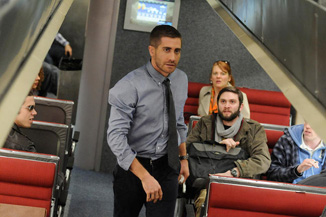Movie Review: Source Code
By Matthew Huntley
April 6, 2011
BoxOfficeProphets.com

Following some haunting aerial photography of downtown Chicago, the plot is immediately set in motion. A man (Jake Gyllenhaal) wakes up disoriented on a train heading toward the city. He’s frightened, confused and sitting across from a beautiful woman (Michelle Monaghan), who tells him, “I took your advice.” He doesn’t know why he’s here or why when he looks in the mirror he doesn’t recognize the man staring back at him. This is not his body. This is not his life. Eight minutes later, the train explodes.
Cut to the same man belted into a metal capsule, barely able to move. Talking to him through a monitor is a military soldier named Colleen Goodwin (Vera Farmiga), who asks him a series of questions to help restore his memory. It turns out he’s also a soldier and his real name is Colter Stevens. As we might have guessed, he’s been recruited for a highly specialized (and classified) mission.
Earlier that day, the train Stevens was on really did explode and everybody onboard was killed. Stevens, however, wasn’t actually on the train. It was a simulation - sort of. In an explanation I wish I could remember word for word, Dr. Rutledge (Jeffrey Wright with a distinguished speech and a cane) tells Stevens the brain of one of the train victims was left well enough intact so the military could utilize it for its short-term memory, which, we’re told, renews every eight minutes. By jacking Stevens into this brain’s “source code” and making it possible for him to relive its last eight minutes, Rutledge hopes Stevens will be able to investigate the train and find the bomber. The goal is not to save the train from exploding (that’s inevitable), but to stop another imminent bomb from heading toward the city. Stevens is repeatedly sent back to the same situation, where the same general events take place. With each eight-minute session, Stevens discovers something new.
Because Source Code has a plot that hinges on tension and surprises, that’s where I stop. Based on what I’ve told you, the premise probably sounds absurd, but because it’s taken seriously and conveyed seamlessly by Ben Ripley’s screenplay and the actors, we’re fully onboard with it. Besides, after a while, the plot doesn’t seem to matter as much as the characters inhabiting it, which is impressive and unexpected for such a high-concept thriller.
As Stevens’ caution and paranoia are replaced by his affection for the beautiful girl across from him, the movie turns from thriller to quasi romantic drama, and it works. The girl’s name is Christine and the more Stevens talks to her during every eight-minute session, the more he likes her. In a way, the thriller plot, which is effective in its own right, becomes secondary to the emotion being generated between these two people. There is a scene so powerful when Stevens and Christine, both lying down, are looking into each other’s eyes that it brings Source Code up to another level. At this point, we become fully invested.
Most thrillers boil down to the last possible minute, with a quick denouement to quickly wrap up all the loose ends. Source Code resolves its plot faster but then goes extra distance with its characters, whose emotions are given more weight and screen time. The last third of the movie has a lot of patience and allows its characters to sit and talk, as when Stevens makes a heartfelt phone call or when Goodwin stares at another character, contemplating her integrity and morality. Such scenes really allow us to care about these people.
The final scene will leave many viewers questioning what they just watched, but not in a frustrating way. We’re more in a state of awe and admiration, for the movie has earned our respect. The director is Duncan Jones, who last made Moon, a superior science fiction thriller. Like that movie, you want to see Source Code more than once for two reasons: 1) to make sure you got the plot right; 2) to let the characters enter your heart again. With most thrillers, it’s usually only the first reason that warrants a re-watch, but Source Code is different. It goes beyond the norm and lets its people become just as intriguing as its premise.